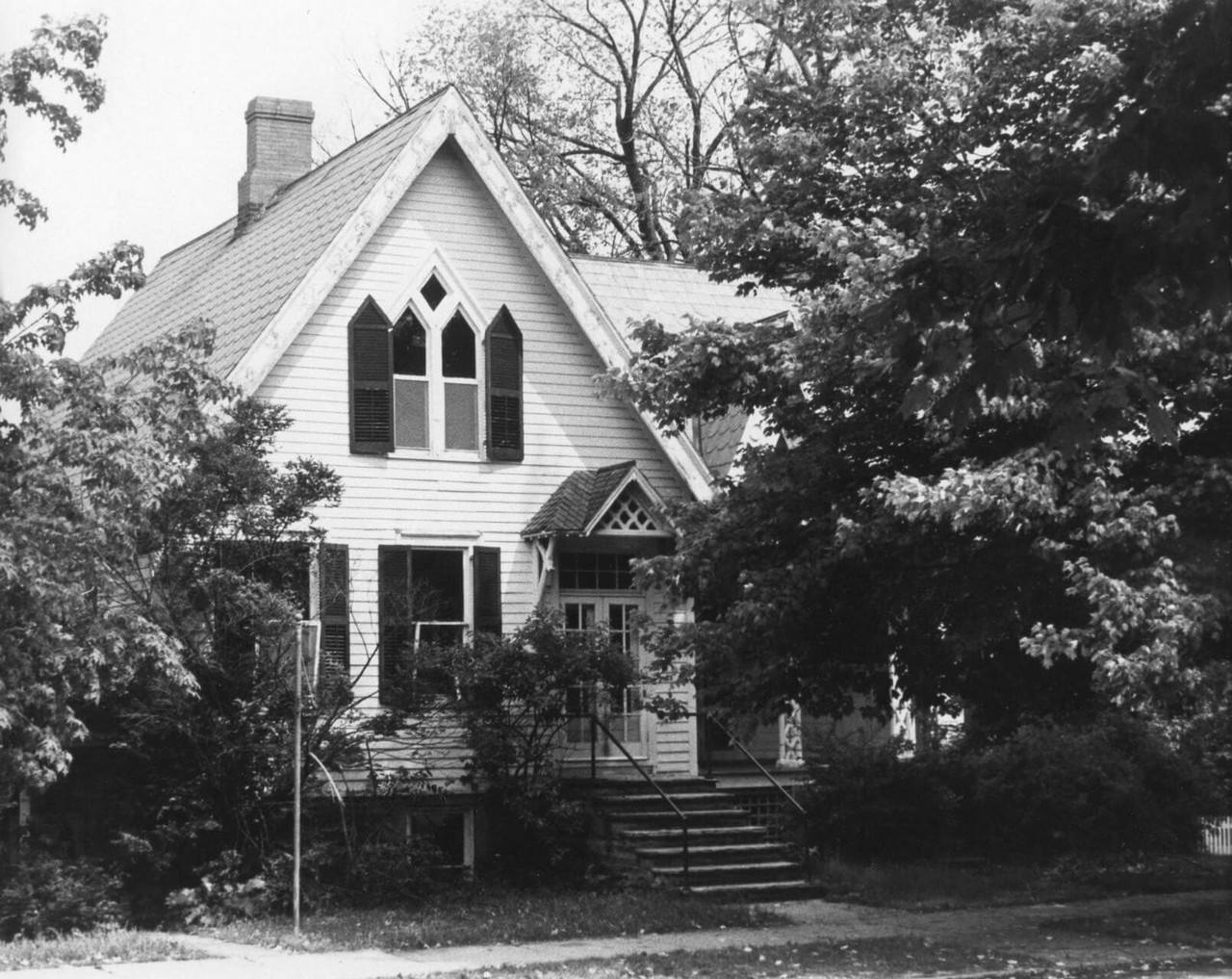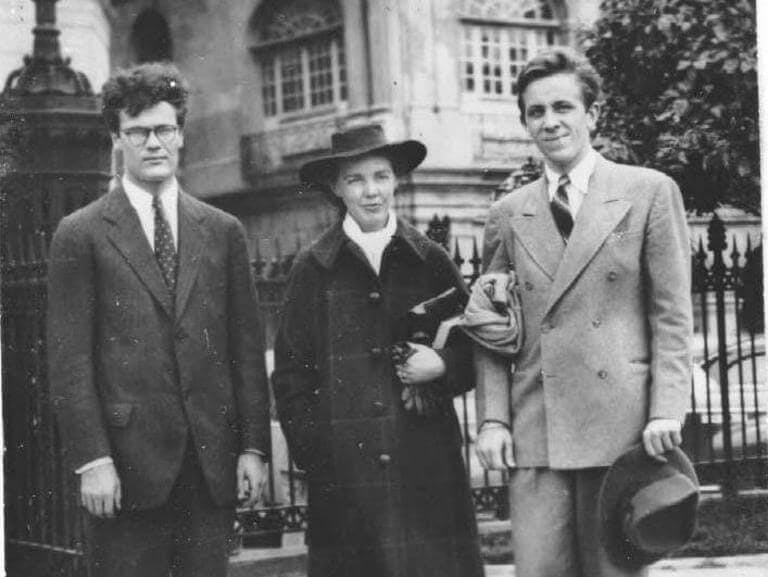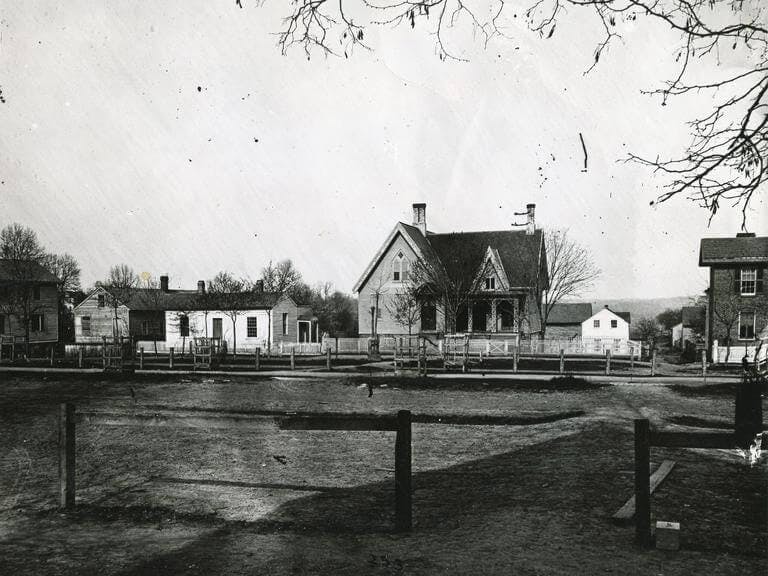The House Atop the Hill
In the early 20th century, a residence housed poets and social rejects who spurned Middle Path and everything it stood for.
Before Robert Lowell ’40 wrote “Skunk Hour,” E.L. Doctorow ’52 wrote Ragtime, and Peter Taylor ’40 wrote A Woman of Means, all three men looked out at Middle Path through the same slanted windows of Douglass House.
A tiny, cramped cottage on the corner of Gaskin Avenue, Douglass House became Kenyon’s early 20th century literary haven, a place where the best young writers in America congregated. Until its demolition in the 1960s to make way for Farr Hall, the house stood as a testament to Kenyon’s commitment to scholarly and artistic achievements in literature.
But while the men of Douglass House later brought the College prestige, the residents often rejected associating with the wider Kenyon community. Located far away from the ivy-covered dormitories of South Campus, the house was its own prideful entity, a space where Kenyon’s literary greats shunned the rest of the population. Over 50 years later, as the house’s successor is set to be demolished, the Magazine examines Douglass House’s legacy, as well as its rivalry with the rest of Kenyon in the 20th century.
Douglass House was first used as a private residence for Kenyon’s third president, David Bates Douglass, in the early 1840s. Throughout its time overlooking Middle Path, the house served additional purposes, even functioning as a World War II infirmary for students of Kenyon’s Army Pre-Meteorological Training Program. Its final tenant was Kenyon’s librarian Edward C. Heintz and his family, who shared the space with the College Cycle and Supply Company before the house was demolished in 1965.
Mostly, though, people knew Douglass House as the house of the poets. Turned into a dormitory in 1938, it provided additional living quarters for transfer students, most of whom came to Kenyon specifically to study under Kenyon Review founder John Crowe Ransom. Among these students was Lowell, who would go on to win Pulitzer Prizes in 1947 and 1974 and become the United States Poet Laureate from 1947 to 1948.
Lowell, a leader in the “confessional movement” of poetry, originally attended Harvard and took classes from Ransom at Vanderbilt but quickly followed him to Kenyon after the professor was offered a faculty position. A classics major, Lowell settled into the house with other students, among them writers Taylor and Robie Macauley ’41. The poet Randall Jarrell supervised the boys as a resident faculty member.

Douglass House, once the home of prestigious literary minds like E.L. Doctorow and Robert Lowell, was knocked down in the 1960s to make room for Farr Hall.
Photo credit: Courtesy of Greenslade Special Collections and ArchivesWith its steep roof, intricate, wood-carved designs, and narrow, pointed windows, Douglass House was often described as a cross between a gingerbread house and a Gothic cathedral. Extending across the right side of the house was a long front porch where students spent their summer nights watching Gambier’s unassuming nightlife pass by. In the spring and summer, the thick foliage of maple trees obscured the entire right portion of the house, prompting residents to gravitate towards windows on the left side for a view of Middle Path.
Through these windows, students could have seen a downtown Gambier not too different from today’s. The town was situated around the section of Middle Path where Farr Hall stands now, with a post office, a bank, two small grocery stores, a barbershop, a gas station, a bakery, and a short-order diner. Douglass House was the only dormitory in this area.
Ransom’s students were not the only notable residents of Douglass House. Carl Djerassi ’43, a significant contributor to the invention of birth control, spent his year at Kenyon living there. He claimed that during that time, he “fell in love with that small men’s college in Gambier, Ohio.” Doctorow, recognized internationally for his historical fiction, was housemates with another Pulitzer Prize-winning resident, James Wright ’52. “We’d be walking across campus,” Doctorow told a Chicago Tribune reporter in 2007, “and we’d see a pile of leaves and we’d kick at them and say, ‘The leaves are falling! The leaves are falling!’ It was our way of making fun of the bad poets on campus.”
In 1955, Taylor, an acquaintance of Lowell’s, penned a short personal essay for The New Yorker titled “A Sentimental Journey” that touches on some of his memories of living in Douglass House. In it, he casts himself and the other transfer students who filled the house’s “mysterious corridors” as outcasts, ostracized by the bulk of Kenyon’s student body.
“Generally speaking, we at Douglass House were reviled by the rest of the student body, all of whom lived in the vine-covered dormitories facing the campus, and by a certain proportion of the faculty," Taylor writes. "I am sure we were thought of as a group as closely knit as any other in the college. We were even considered a sort of fraternity. But we didn’t see ourselves that way. We would have none of that. Under that high gabled roof, we were all independents and meant to remain so.”

Lowell, Lowell’s first wife Jean Stafford, and Peter Taylor pose for a picture in New Orleans.
Photo credit: Courtesy of Wikimedia Commons
Douglass House once stood facing a mostly-bare Middle Path.
Photo credit: Courtesy of Greenslade Special Collections and ArchivesThe hostility seemed to go both ways. According to Taylor, “Middle Path was the epitome of everything about Kenyon that we wanted no part of.” From his window overlooking Kenyon’s central artery, he would watch polo players returning from the field on horseback, amateur flyers trekking back from Kenyon’s private airfield, still donning their flight goggles, and fraternity members singing the same songs about Philander Chase that are sung today in the First Year Sing.
The Douglass House men wanted no part of Kenyon’s traditions or community. They did not even care about the beautiful countryside. They had come to campus for Ransom and the writing program and refused to take part in much else.
Tensions between the house and the rest of campus were public enough to fuel multiple satirical Collegian articles. A 1938 issue includes an article titled “Rat Racing In Tub Upsets Poets Calm,” which contains only 56 words:
“Douglass House was thrown into utter confusion early this week by a large vicious racing rat. This nasty creature raced all over the bath tub. The student body of Kenyon in a popular front vote gave thanks to the rat for disclosing the fact that Douglass House has a bath tub contrary to general college practise.”
The Collegian was not generally a platform for humor writing, but when it came to Douglass House, its editors could not resist taking sharp jabs at the occupants of the small, Carpenter Gothic-style house on Gaskin Avenue. In 1941, the paper was even forced to include the following:
“‘NOTICE: Any features appearing in the Collegian concerning Douglass House are not necessarily factual and should be interpreted as such.’ – the Editors.”
Taylor’s New Yorker essay ends with his return to Douglass House after an exhausting and disappointing trip to New York City. Back on campus, he finds a small party of the Douglass House men in his room, using his hot plate and sitting on his bed. Taylor’s outrage is quickly muffled by his laughter, and a sudden sensation of relief comes over him.
To Taylor and his friends, Douglass House was home. And though Farr Hall will be torn down this summer, it will be replaced by houses perhaps not too different from what Douglass House once was.
